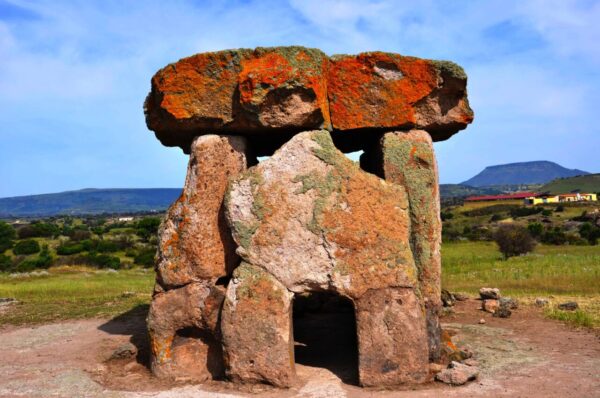Modelling of masonry structures Seismic assessment of monuments
Structural assessment of Dolmen of Sa Coveccada, Mores, Sardinia
Overview
Dolmens are megalithic sepulchral constructions formed by vertical stone blocks supporting horizontal cap-stones. These archaeological monuments, which have been built 5000-6000 years ago, can still be admired in several Countries worldwide and provide precious information on Neolithic populations. The Dolmen of Sa Coveccada is located near Mores, Sardinia, Italy. It dates back to the first half of the 3rd millennium BC and is considered one of the most important ones in the Mediterranean area, both for its size and for its particularities, testifying to the evolution of prehistoric sepulchral architecture in the region.
Due to the severe deterioration of material surfaces, the collapse of some portions of the cap-stone and the extensive crack pattern, the monument underwent a first restoration in 2011, but still needs important retrofitting. Amongst the various issues under investigation, which also include the state of conservation of the material, the biodeterioration of the surfaces, the protection measures, and the touristic exploitation strategies, the structural stability, especially of the top slabs, is considered the main concern, but it has never been assessed to date.
This research aims at assessing the stability of the stone units and identifying possible retrofitting strategies and provides an example of the potential application of engineering structural assessment tools to archaeological sites, which is as unusual (architects, archaeologists, restorers are much more often involved in these situations) as extremely useful for the conservation of architectural heritage.
Dolmen of Sa Coveccada, Mores, Sardinia
The main megalithic constructions that were built in the prehistoric era consisted mainly of large blocks of stone. Among these structures, “dolmen” indicates a megalithic sepulchral construction formed by at least three or more stone blocks. More specifically, it is made out of vertical elements (called “orthostats”) and one or more slabs of stone to cover the sepulchral compartment. These monuments are still widespread in various European areas, including Italy, especially in Sardinia.
The Dolmen of Sa Coveccada is located about 10 km from the municipality of Mores, in the province of Sassari. This monument is considered the most important dolmen in Sardinia, both for its size and for its particularities, and it is also regarded as an important testimony in the evolution of the sepulchral architecture of the prehistory of the region. This Dolmen, chronologically placed around the first half of the 3rd millennium B.C., has recently undergone restoration interventions, the most important in 2011. In spite of these works, the monument now requires further measures, both for the restoration of the stone surfaces, widely cracked, and for structural stability, especially of the top slabs.
Restoration works
Dolmen of Sa Coveccada is now undergoing new analysis, assessment and restoration works. The workgroup includes Carla Tomasi and Angela Savalli, (Carla Tomasi srl, coordinator), specialized in the restoration of stone materials and archaeological sites, Alessandro Massa (Esplorativa Architetti), for 3D laser and photogrammetric survey, Lorenzo Lazzarini, geologist, for scientific studies on stone material, Ornella Salvadori, biologist, for investigations on biological deterioration, and Prof. Stefano De Santis and Luca Di Domenico, Roma Tre University, for structural assessment and design.
The work is appointed by the Regional Secretariat of Sardinia, under the coordination of Arch. Patrizia Tomassetti, and the supervision of RUP Massimo Casagrande, and the contribution of the archeologist Pina Corraine, and the restorer Charlotte Montanaro.
Among the activities in progress, in addition to various laboratory analyses on samples taken in the field, there is the evaluation of the state of conservation of the stone material, the conditions of biodeterioration of the surfaces of the monument and the evaluation of the structural stability of the monument. These activities aim at developing a proposal for a restoration and retrofitting works to ensure the conservation of the monument.
